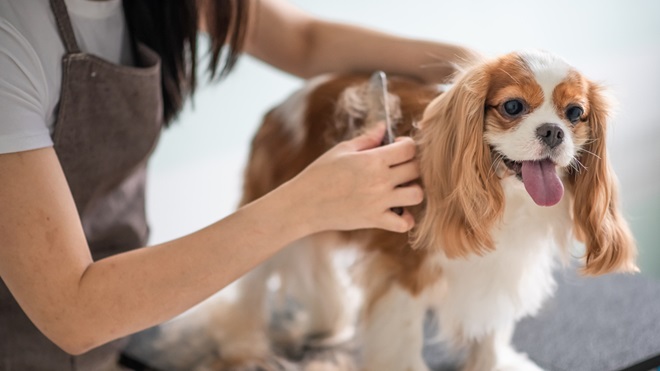Pets are a great addition to any home because they provide companionship, make us laugh, and often help keep our feet warm at night. However, depending on the pet you have, they can also leave behind lots of hair. Most pet owners recognise what a struggle that can be. It can be problematic as it sticks to furniture, carpets, and clothes. Even though many pets go through an intense shedding phase only once or twice a year, in reality, their hair is falling out constantly and being replenished. Fortunately, there are ways to stop it from taking over your home.
Groom your pet
The best tactic is to treat the problem at its source. Purchase a good quality brush or a comb and regularly groom your pet outside. Consider getting a brush that targets the undercoat, as it’s an area that tends to shed the most. A bristle-type brush is most suitable for pets with short hair, while pets with longer fur will often need a rake brush. Making this a regular part of your pet’s routine can target the hair before it’s had the chance to fall out and build up around your home.
Some people say that regular bathing is the best way to reduce the amount of fur that your pet sheds. However, this varies from animal to animal, depending on the type of coat it has. Consult with your vet for brush recommendations before deciding on the way to treat your pet’s fur.
Keep your home clean
If you already have a buildup of pet hair, it might be a good idea to call a professional cleaner for deep cleaning. They can get right to your carpets and rugs and perform upholstery cleaning that will make your furniture look like it’s brand new. Once that’s done, you can start with a clean slate and stay on top of your home cleaning routine.
Lint rollers and sheets
One way to reduce the amount of pet hair left behind is to place lint rollers over the house and purchase lint sheets for your furniture. The rollers have a sticky film, which picks up the hair when you roll them over your clothes, cushions, seat pads, etc. You simply press them onto sofa cushions, curtains, and any large areas of upholstery, and they’ll collect any hairs and dust that have settled.
Vacuum cleaner
You can also purchase a vacuum cleaner that is specifically designed for pet hair. These work slightly differently from normal vacuum cleaners because they have specific suction settings and brushes. This allows you to pick up all pet hair, even the annoying, wiry ones that seem impossible to get rid of. It may seem excessive, but vacuuming daily will prevent buildup, especially if your pet has entered its shedding cycle. Don’t forget to vacuum in inconspicuous areas where fur can also build up, such as under radiators, beds, and around table legs. Vacuuming will also help reduce any potential pet smell from becoming too strong.
If you already have a regular vacuum cleaner and don’t want to spend extra money on a second one, there are handheld pet vacuums that remove embedded hair from furniture and clothing.
Rubber brush
If you don’t have the time to vacuum daily, run a rubber brush over the carpets and furniture. The rubber creates a static charge when it comes in contact with the rug and upholstery and attaches the pet hair into its bristles. It also forms balls of fur on the surface of the furniture, which you can pluck off or vacuum afterward.
Regular Bedding Change
Pet hair can stick to quilts, comforters, pillows, and sheets so laundering all bedding at least once a week is necessary. Put pet hair-covered items, such as blankets and pillowcases, in the dryer with a dryer ball before washing. The fur should come off the fabric and get stuck in the lint trap. Don’t forget to also clean the collected hair from the dryer’s lint screen.
Dusting
Depending on what pet you have, you may also notice hair building up on hard surfaces such as tables and shelves. Make sure to dust these areas and wipe the kitchen and bathroom counters regularly.
Air purifier
Getting rid of pet hair from the air completely may not be possible, but using an air purifier with filtration can trap airborne pet hair and particles such as dander, bacteria, dust, and lint. Make sure to change the air filters frequently.
Restrict your pet
Consider restricting the areas that your pet is allowed in during its shedding period. If dog hair is a problem on your bedding, give your pet a bed of their own to discourage them from sleeping where you don’t want their fur to build up. If you struggle with saying “no” to your pet, use throws on the pieces of furniture that it tends to spend the most time on.
Regular Walk and Exercise
If you have the type of pet that can be taken out for walks, doing this regularly can reduce the amount of hair they shed indoors. Most pets’ coats are to go through major shedding during the spring and summer when you can let them outdoors to play and explore.
Final Words
Finding pet hair around is inevitable when you decide to take up a furry companion. Luckily, you can control that. Once you adopt the habit of doing the things above, you’ll notice how easy it is to maintain your home and stop pet hair from taking over it. Keeping your home and pet clean should be a priority to prevent its hair from building up on hard surfaces, rugs, upholstered furniture, and you.

